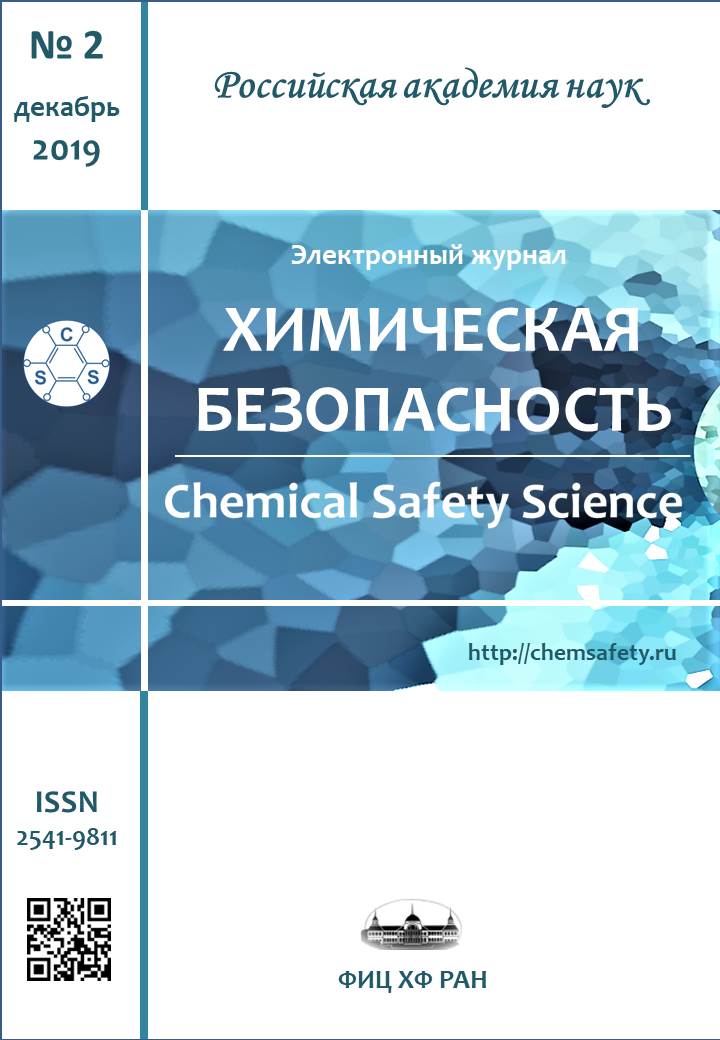Chemiluminescence-Based Determination of Unsymmetrical Dimethyl Hydrazine in Aqueous Media
Abstract
A chemiluminescence mediated procedure for quantitative determination of unsymmetrical dimethyl hydrazine (UDMH) in water bodies is proposed which can be applied for prompt quality control of aqueous media. The UDMH analysis is based on determining an oxidizing agent uptake required for neutralization of the analyzed compound. Potassium permanganate acidified with concentrated sulfuric acid for pH value adjustment up to 1–2 is used as the oxidizing agent. The first step of the procedure involves interaction of potassium permanganate with UDMH followed by chemiluminescence reaction of unreacted oxidant residues with luminol. Measurements of changes in the intensity of light emission in the chemiluminescence reaction are performed for determination of concentration of the oxidizing agent in the reaction mixture, which provides quantitative determination of UDMH content in the sample. The concentration of UDMH is calculated from maximum luminous intensity in the luminol – acidified potassium permanganate system. The proposed method has demonstrated a superior accuracy as compared to the traditional photocolorimetric method for determining UDMH. Moreover, the chemiluminescent reaction allows to reduce significantly the duration of the analytical procedure and accelerates the data processing (the average time of measurement does not exceed 2.5 minutes), i.e. provides express-analysis of UDMH in aqueous solutions, in particular, in the field conditions and mobile laboratories.
References
Passport of National Project “Ecology” [in Russian]. http://www.mnr.gov.ru/activity/directions/natsionalnyy_proekt_ekologiya/ (accessed: 11.12.2019).
GOST [State Standard]. Water Quality. Terms and Definitions. М: IPK Izd. standartov, 2003 (Revised edition) [in Russian].
Methods and means of ensuring chemical safety. Ed. By A.V. Roshchin. M.: Buki Vedi, 2016. 356 p. [in Russian].
Malysheva A.G., Sotnikov E.E., Moskovkin A.S. // Gigiena i sanitariya [Hygiene and sanitation]. 2003. No. 5. P. 74 [in Russian].
Messineva E.M., Fetisov A.G., Manuilova N.B. // Ekologiya i promyshlennost’ Rossii [Ecology and Industry of Russia]. 2018. V. 22. No. 8. P. 55 [in Russian]. DOI: https://doi.org/10.18412/1816-0395-2018-8-55-59.
Hazardous chemicals. Nitrogen-containing organic compounds. Handbook. Ed. by V.A. Filov and B.A. Kurlyandskiy. L.: Khimiya, 1992. P. 245 [in Russian].
Ivanova L.A. // Rossiya molodaya: peredovyie tekhnologii – v promeshlennost’ [Young Russia: advanced technologies into industry]. 2015. No. 3. P. 153 [in Russian].
Bugaev P.A., Antushevich A.E., Reinyuk V.L. et al. // Sovremennye problem nauki i obrazovaniya [Modern problems of science and education]. 2017. No. 4. P. 31 [in Russian].
Sanitary Regulations and Norms 1.2.2353-08. Carcinogenic factors and basic requirements for prevention of carcinogenic hazards. М.: Fed. tsentr gig. epidem. Rospotrebnadzora, 2011 (amended in 2015) [in Russian].
Tulupov P.E. et al. Chemical transformations of dimethylhydrazine in air and identification of the products. In: Air and soil pollution. М.: Gidrometeoizdat, 1991. P. 87 [in Russian].
Hygienic Standard 2.1.7.2735-10. Maximum permissible concentration (MPC) of 1,1-dimethylhydrazine (heptyl) in soil. М.: Rospotrebnadzor, 2010 [in Russian].
Hygienic Standard 2.1.5.1315-03. Maximum permissible concentrations (MPCs) of chemicals in water of water bodies for domestic and drinking water and cultural and domestic water use М.: 2003[in Russian].
Mestre Y.F., Zamora L.L., Calatayud J.M. // Luminescence. 2001. V. 16. No. 3. P. 213. DOI: 10.1002/bio.608.
Robards K., Worsfold P.J. // Anal. Chim. Acta. 1992. V. 266. No. 2. P. 147. DOI: https://doi.org/10.1016/0003-2670(92)85040-D.
Dodeigne C., Thunus L., Lejeune R // Talanta. 2000. V. 51. No. 3. P. 415. DOI: https://doi.org/10.1016/S0039-9140(99)00294-5.
Marquette C.A., Blum L.C. // Anal. Bioanal. Chem. 2006. V. 385. P. 546. DOI: https://doi.org/10.1007/s00216-006-0439-9.
Roswell D.F., White E.H. // Methods in Enzymology. 1978. V. 57. P. 409. DOI: https://doi.org/10.1016/0076-6879(78)57038-9.
Golovina A.P., Levshin L.V. Chemical luminescent analysis of inorganic substances. М.: Khimiya, 1978. P. 248 [in Russian].
Albrecht H.O. Ueber die Chemiluminescenz des Aminophthal saure hydrazide // Z. Physik. Chem. 1928. V. 136. P. 321.
Harris L., Parker А.S. // J. Am. Сhem. Soc. 1935. V. 57. No. 10. P. 1939. DOI: https://doi.org/10.1021/ja01313a056.
Zellner C.N., Dougherty G. // J. Am .Сhem. Soc. 1937. V. 59. No. 12. P. 2580. DOI: https://doi.org/10.1021/ja01291a031.
Bernanose A. La chimiluminescence des hydrazides. Mecanisme du phenomene // Вull. Soc. France. 1951. V. 18. P. 329.
Bremer T. Le mechanisme de la chemiluminescence en solution // Bull. Soc. Chim. Belges. 1953. V. 62. P. 569.
Erdey L., Buzas I. // Anal. Chim. Acta. 1960. V. 22. P. 524. DOI: https://doi.org/10.1016/S0003-2670(00)88331-2.
White Е.Н., Bursey М.М. // J. Am. Chem. Soc. 1964. V. 86. No. 5. P. 941. DOI: https://doi.org/10.1021/ja01059a051.
White Е., Zafiriou О., Kagi Н. // J. Am. Chem. Soc. 1964. V. 86. No. 5. P. 940. DOI: https://doi.org/10.1021/ja01059a050.
Pan J., Huang Y., Shu W., Cao J. // Talanta. 2007. V. 71. No. 5. P. 1861. DOI: https://doi.org/10.1016/j.talanta.2006.08.030.
Pilipenko A.T., Pyatnitskiy I.V. Analytical chemistry. М.: Khimiya. 1990. Part 1. 480 p. [in Russian].
Vinogradov A.P. Modern methods of analysis: Methods for studying chemical composition and structure of substances. In: To the 70th anniversary of acad. A.P. Vinogradov. М.: Nauka, 1965. 335 p. [in Russian].
Patent 2090863С1 Russian Federation, 1997.
Lebedeva M.I. Analytical chemistry and physicochemical methods of analysis. Tambov: Izd. TGTU, 2005. P. 67 [in Russian].
Buryak A.K., Serdyuk T.M., Ul’yanov A.V. // Theoretical Foundations of Chemical Engineering, 2011. V. 45. No. 4. P. 550. DOI: 10.1134/S0040579510051057.
Pestunova O.P., Elizarova G.L., Parmon V.N. // Zhurnal prikladnoi khimii [Journal of Applied Chemistry]. 1999. V. 72. No. 7. P.1147 [in Russian].
Copyright (c) 2019 V. V. Usin, V. A. Pashinin, N. Yu. Kovaleva, E. G. Raevskaya, and A. V. Roshchin

This work is licensed under a Creative Commons Attribution-NonCommercial 4.0 International License.












